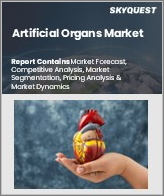
세계의 인공 장기 시장 규모는 2023년 285억 달러, 2024년 307억 5,000만 달러에서 2032년에는 565억 달러로 성장하고, 예측 기간(2025-2032년) CAGR은 7.9%를 보일 것으로 예측됩니다.
세계적으로 고령화가 진행되면서 장기 이식의 중요성이 크게 증가하고 있으며, 특히 이식을 받는 동시에 이식을 원하는 65세 이상 인구에서 그 중요성이 두드러지게 나타나고 있습니다. 이러한 인구 통계가 증가함에 따라 이식 후 합병증 위험이 높아짐에 따라 보철기구에 대한 수요도 증가하고 있습니다. 환자 수 증가는 더 많은 환자들이 시술을 필요로 하기 때문에 이식 대기자 수가 증가할 수 있다는 것을 의미하며, OPTN Modernization Initiative와 같은 혁신은 장기 이식에 있어 시스템의 효율성과 데이터 투명성을 높이는 것을 목표로 합니다. 또한, 3D 바이오프린팅과 같은 발전은 거부반응의 위험이 낮은 인공장기를 만드는 데 도움을 줄 수 있다는 점에서 지지를 받고 있습니다. 장기 및 기증자 적합성 평가에 인공지능을 통합하는 것은 회복과 환자 수용을 위한 의사결정 과정의 혁신적 변화를 의미합니다.
Global Artificial Organs Market size was valued at USD 28.5 billion in 2023 and is poised to grow from USD 30.75 billion in 2024 to USD 56.5 billion by 2032, growing at a CAGR of 7.9% during the forecast period (2025-2032).
The global aging population is significantly increasing the importance of organ transplantation, particularly among individuals over 65 who are both recipients and seekers of transplants. As this demographic grows, so does the demand for prosthetic devices, driven by their heightened risk of post-implantation complications. The growing numbers indicate a potential increase in transplant waiting lists as more patients require procedures. Innovations such as the OPTN Modernization Initiative aim to enhance system efficiency and data transparency in organ transplantation. Additionally, advancements like 3D bioprinting are gaining traction for creating artificial organs with a lower risk of rejection. The integration of artificial intelligence in assessing organ and donor compatibility represents a transformative step in decision-making processes for both recovery and patient acceptance.
Top-down and bottom-up approaches were used to estimate and validate the size of the Global Artificial Organs market and to estimate the size of various other dependent submarkets. The research methodology used to estimate the market size includes the following details: The key players in the market were identified through secondary research, and their market shares in the respective regions were determined through primary and secondary research. This entire procedure includes the study of the annual and financial reports of the top market players and extensive interviews for key insights from industry leaders such as CEOs, VPs, directors, and marketing executives. All percentage shares split, and breakdowns were determined using secondary sources and verified through Primary sources. All possible parameters that affect the markets covered in this research study have been accounted for, viewed in extensive detail, verified through primary research, and analyzed to get the final quantitative and qualitative data.
Global Artificial Organs Market Segments Analysis
Global Artificial Organs Market is segmented by Organ Type, Fixation, End-User and region. Based on Organ Type, the market is segmented into Artificial kidney, Artificial liver, Artificial lungs, Artificial pancreas, Artificial heart and Other organ types. Based on Fixation, the market is segmented into Implantable and Wearable. Based on End-User, the market is segmented into Hospitals, Academic and Research Institutes and Specialty Clinics. Based on region, the market is segmented into North America, Europe, Asia Pacific, Latin America and Middle East & Africa.
Driver of the Global Artificial Organs Market
The Global Artificial Organs market is significantly driven by the rising prevalence of chronic illnesses like kidney failure, heart disease, and liver disease. As more patients experience organ dysfunction, the need for prosthetic organs, including dialysis machines, artificial hearts, and liver support systems, is rapidly increasing. This escalating demand is further accentuated by an aging population and deteriorating quality of life, contributing to an urgent need for life-saving medical interventions. Consequently, the surge in chronic disease cases is propelling the growth of the artificial organs market, highlighting the critical role these technologies play in improving patient outcomes and enhancing overall quality of care.
Restraints in the Global Artificial Organs Market
Although there have been significant advancements in technology, the exorbitant costs associated with prosthetics and related medical procedures continue to hinder the growth of the global artificial organs market. The extensive expenses incurred during the research, development, and manufacturing phases of these devices often render them unaffordable for a large segment of the global population, particularly in developing regions. Consequently, individuals with lower income levels or inadequate access to healthcare services face considerable barriers in obtaining prosthetic solutions. This financial constraint significantly restricts the reach and effectiveness of artificial organs, limiting their availability to those who need them the most.
Market Trends of the Global Artificial Organs Market
The Global Artificial Organs market is witnessing a significant trend driven by the integration of 3D printing technology in prosthetics. This innovation allows for the creation of customized, patient-specific organs that enhance accuracy, functionality, and biocompatibility, addressing individual healthcare needs more effectively. The ability to rapidly produce high-quality prosthetics at lower costs not only increases accessibility but also accelerates the manufacturing process, making 3D printing a pivotal segment within the market. As a result, stakeholders are increasingly investing in this technology, anticipating its role in reshaping healthcare solutions and improving the quality of life for patients worldwide.